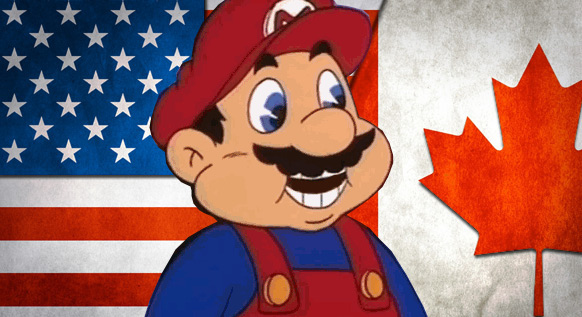Mario Takes America is a cancelled action platformer game that was in development from 1992 to 1994 at the Toronto-based Cigam Entertainment for the ill-fated Philips CD-I console. This was intended to be the third Mario game planned for the CDI, following Hotel Mario and the unreleased Mario Wacky Worlds. It would have formed a trilogy of Nintendo-licensed Mario games published by Philips, just like the infamous Zelda CDI trilogy: Zelda’s Adventure (by Viridis), Zelda: The Wand of Gamelon and Link: The Faces of Evil (by Animation Magic).
Mysteriously, while even the unfinished Wacky Worlds gained some exposure from savvy prototype hunters online, Mario Takes America was since forgotten by the wider world, fading into obscurity, and until recently, next to zero information has been available on it. However, thanks to an anonymous contributor, research by Interactive Dreams, LiamR and a former Cigam employee on the AssemblerGames Forum, we are able to preserve some more memories about this unreleased Mario project.
“The idea behind Mario Takes America was to educate younger audiences about American culture, under the guise of a fun 3D platformer. It was to feature Mario traveling all over the country, running around in levels based off real life locations, such as New York.“
A video from the development of the game was reported to have been shown at the New York CDi 3 conference in October 1993 and at the 1994 Winter CES, according to Interactive Dreams, but unfortunately, this footage is still missing. We know from the cancelled Mario’s Wacky Worlds that unfinished CDI games are not particularly that great to look at or play, but we hope to be able to see some screenshots and footage from Mario Takes America one day.
Super Mario in the USA?
In the beginning, a key part of the initially outlined concept of Mario Takes America involved levels made up of real life photography, overlaid by 2D sprites to illustrate characters. Describing the game’s intended visual style, one of the artist who worked it likened to the movie, “Who Framed Roger Rabbit?“. The photos and videos that made up the title’s locales were filmed on location and Cigam travelled all around the US to capture them.
Here are some preserved photos from the Mario Takes America team while they were filming the backgrounds:
- The Black Bayou north of Shreveport Louisiana – The setting for the Mario Bayou Boat Chase
- Camera setup and speedboat used to film the background places. These were Louisiana film people hired for the shoot day.
- On a high speed pass through the main channel. Left to Right – Boat Driver, Location Scout, Main Mario Takes America Artist in Back Row, Producer – Howard Greenspan
- Planning the final route for the background plate. This was north of a town called Vivian. Louisiana
- The Niagara Falls Sequence – a Second Bell Jet Ranger arrives. They elected to use a helicopter with skids above the falls as they did not want to float over the edge if they landed on the water.
- The crew for the day- Cameraman (hired for the day) Producer Howard Greenspan, Main Mario Takes America artist Michael Borthwick, Pilot Dave Thomassini, Pilot 2 (unknown)
- Cameraman, Main Mario Takes America artist Michael Borthwick, Producer Howard
- Below the falls (Mario in a barrel) Rapids sequence Helicopter with floats takes off. They were shut down after 2 trips down the rapids because they flew under the cable car.
“The film crew even used a helicopter to shoot some of the more tricky sequences. […] We compensated by filming strictly defined POV areas like the Niagara River, open channels in the Louisiana Bayou and highways in Monument Valley. That was the best part – filming the background assets all over the US in camera cars, speedboats and helicopters.“
“Mario was rendered as he was in the cartoons. It was 2D Animation but we added shading to match wherever the light source was in the background film footage. […] All the footage gathered in each sequence would be put into a Movie Premiere at Graumanns Theathre in Los Angeles – all about Mario’s travels.“
Here are some quick mockups made by us to show how Mario Takes America would have looked on the Philips CDI:
The former Cigam employee told us:
“Your mockups of the game are in theory correct, but the Marios were much smaller (except in the cinematic scenes) and of lower resolution.“
According to UK CD-i magazine issue 3 from 1993:
“Software company CIGAM has had to shoot original footage on location for much of the title, including scenes where Super Mario flies over the Manhattan skyline, falls over a waterfall and skims across a lake by boat.
The film crew used a helicopter to shoot some of the more tricky sequences, and it is believed this will be the first CDi game to use such dramatic footage.
The storyline involves Super Mario arriving in New York, traveling across the US and eventually arriving in Hollywood where he stars in his own interactive film. He travels by truck, train, car, aeroplane, helicopter and even a motorbike!
No release date has yet been given for the title, but early clips were on show at the CDi 3 Conference in New York in October. The film footage looks quite stunning and will bring a new degree of realism to the game.“
Thanks to Matt for the second scan from CD-i World Magazine!
In Mario Takes America there were “first person view” (with Mario shown from front or behind) on-rail levels / sequences that used those filmed backgrounds, including:
- New York / Manhattan Skyscraper Helicopter Ride (with “New York New York” as background music)
- Niagara Falls Upper and Lower Rapids Barrel Game
- Louisiana Bayou with a Speedboat
- Vintage Steam Train fight (on top of travelling boxcar) in Texas
- Badlands Motorcycle Chase
- Las Vegas Neon Race (never completed)
- Los Angeles Car Race on Highway at Night
All of these were coded and playable, but as the Philips CD-I was not enough powerful, the team had to degrade a lot of the animation to get the collision detection to work.
“We did manage to get Mario to work on several different levels in perspective. He could drive into the scene a bit and then back out to avoid obstacles, but it was a nightmare for the Tech Boys to code and keep him exactly on the highway or river sometimes.“
There were also 2D Platform sequences with images of real-world places as the backgrounds including:
- Fort Knox Gold (patterned after the one in 007 Goldfinger)
- Carlsbad Caverns
- Hollywood Sign
- Final boss battle at Graumann’s Theatre
Some more places that were recorded are:
- a Detroit Auto Factory (never completed)
- Florida Space Shuttle Ride
- Monument Valley Motorcycle Race on Highway (they even got the rights to Steppenwolf’s “Born to Be Wild” to be used in this level)
As we can read from the memories of a former Cigam employee:
“As far as the gameplay went, the style of game was driven by the footage that was shot. The New York Skyline was a 2D side scrolling game shot out the left side of a helicopter. Most of the footage was shot moving towards the action, behind Mario. This was true for the Niagara Falls scenes, The Bayou, the Monument Valley Highway and the LA Freeway scenes. There was a fight on the top of a train with the camera pointed forward on one of the passenger cars where you could see the Koopas climbing up the side of the car in front of you. They would reach your position and fight with Mario. Each enemy had a different fighting style. “
“The Space Shuttle game had Mario using the Canadarm to both pull coins into the shuttle bay and to punch enemies and asteroids which could contain more coins. In the Hollywood Sign game you would chase electrical charges around the letters.”
The team behind Mario Takes America, Cigam Entertainment and their Cinevillage office, was founded by a Canadian investor named Howard Greenspan, who sadly died some years ago. It seems that there were only a couple of developers at Cigam and the very first programmer who was hired quit the job after only 3 weeks, after reading the CDI’s tech specs. He said: “Our whole foundation is built on sand“.
Once the team had captured the materials for its backgrounds and eventually began importing them into the game, disaster struck. Due to the CD-I’s restrictive hardware capabilities, once the team had programmed the backdrops into the stages, they had very little memory left to add in their planned Mario sprites. The result was a technical nightmare for its programmers.
What happened to Mario Takes America?
The project was too ambitious and the CDI was a huge failure. Even Philips, who were once interested in the game, saw that Cigam was unable to fulfill the original concept and decided to cut their funds. Cigam had to stop their work on Mario Takes America, but Howard was still hopeful to find another publisher with new funds and rework the game under a new identity.
At one stage, the producer even attempted to form a partnership with SEGA to replace Nintendo’s mascot with Sonic The Hedgehog. However, this never went forward as his attempts to contact them about it went ignored. He then asked the art department to replace all the Mario sprites with a new character of their own creation, called “Metal“.
“Metal was a Rock & Roll Star who looked like Dee Snider from Twisted Sister. He had a big Roadie Assistant named “Heavy” (I kid you not) who would help out from time to time. As I said we simply renamed all the sprites and had the programming dept plug the new sprites into the code. MRIONY04 became HEVYNY04 and so on.”
As crazy as it sounds, even with this change, the project was doomed. Soon, Cigam Entertainment closed for bankruptcy, and the Canadian Imperial Bank of Commerce proceeded to mortgage all of the company’s assets.
“In November of 1994, Cigam relied on those new policies to obtain a line of credit from CIBC to finance its operations. However, during the past summer, CIBC managed to mishandle the account and the claims and policies made previously no longer applied. As a consequence, the bank demanded additional security — a collateral mortgage on Mr. Greenspan’s personal property. Cigam’s banking arrangements deteriorated rapidly, causing immediate negative affects to the operations of the company.
During these events, Mr. Greenspan attempted to have CIBC value his company’s assets in accordance to the new policies it had claimed in April of 1994. He brought his concerns to senior executives and the CIBC ombudsman, but they claimed to have no knowledge of the new lending policies the president had declared. Eventually, this led to the bankruptcy of Cigam Entertainment Inc.”
What happens in Canada stays in Canada
Amazingly, it appears that the Canadian Imperial Bank of Commerce reposessed all of the game’s assets from Cigam, which goes a big way to explaining why so little information and media of this game was ever recovered. It is still very possible that the Mario Takes America assets could still be lost somewhere in the CIBC archives. Maybe one day, some nice CIBC employee will rediscover them and decide to share this piece of gaming history with the world, but until then, we’ll still have to dream about this hugely obscure Mario game that was never released for the CDI.
What do you think about this unseen game? Give your vote!
Would you like to add more info, screens or videos to this page? Add a comment below!
- Dragonkind [XBOX/PS2 – Cancelled] - 02-12-2023
- Damnation: Hell Breaks Loose [PC – Prototype] - 07-10-2023
- Marvel 2099 : One Nation Under Doom [PC, PSX – Cancelled] - 03-06-2023

![Mario Takes America [CDI – Cancelled] Mario Takes America [CDI – Cancelled]](https://www.unseen64.net/wp-content/uploads/2014/09/mario-takes-america-cancelled-videogame-670x300.jpg)















Very interesting and though it’s unfortunate because of that bank we will never be able to see the main prototype parts of the game, I think it’s probably better that this game didn’t get made so mario could keep adventuring in his own crazy and cool world. Thanks for bringing this to light.
CD-i Magazine – Issue 03 (1993)(Haymarket Publishing)(GB) (1993)
https://archive.org/stream/CD-i_Magazine_Issue_03_1993_Haymarket_Publishing_GB#page/n3/mode/2up
Disappointing for sure! But if you have every played a game on the CD-i this is only a good thing. The controller that came with the CD-i 220 Series was awful.